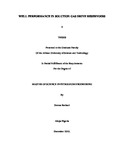| dc.contributor.author | Karikari, Dorcas | |
| dc.date.accessioned | 2016-09-05T11:38:27Z | |
| dc.date.available | 2016-09-05T11:38:27Z | |
| dc.date.issued | 2010-12-12 | |
| dc.identifier.uri | http://repository.aust.edu.ng/xmlui/handle/123456789/468 | |
| dc.identifier.uri | http://library.aust.edu.ng:8080/xmlui/handle/123456789/468 | |
| dc.description.abstract | The practical application of various production parameters and relations to predict the well performance analysis of a solution gas drive reservoir is the primary objective of this study. These parameters include: IPR (inflow performance relation), OPR (outflow performance relation) and PI (productivity index). Theoretical data was used to predict the performance behaviour of a solution gas drive reservoir from start of production till its abandonment. IPRs and OPRs were developed during the forecasting, over the life of the reservoir. IPRs of a naturally fractured reservoir were also developed for both vertical and horizontal wells. Hagoort equation was used to develop the NFR IPRs. The storativity ratio was varied to investigate its effect on the productivity index equation in transforming single-porosity reservoir into a double-porosity reservoir productivity index. It was observed that there is no significant difference in the productivity index obtained with single porosity and that of double porosity developed by Hagoort.
A new method of estimating productivity index in a horizontal well using the shut in pressure data in the absence of bottom-hole flowing pressure was developed. The available method of estimating productivity index in a horizontal is based on steady or pseudo-steady state flow regime. The reservoir pressure drop may exhibit limited aquifer or pressure support which makes the reservoir’s flow regime to behave like neither steady nor pseudo-steady state. Therefore, the steady or pseudo-steady state equations developed for estimating productivity index are not applicable In this work, historical shut in pressure data acquired were used as the average reservoir pressure to compute the pressure drop due to a particular production rate at any time. The productivity index was then computed. Field data were used to test the model and good results were obtained. | en_US |
| dc.language.iso | en | en_US |
| dc.subject | Karikari Dorcas | en_US |
| dc.subject | Dr. Alpheus Igbokoyi | en_US |
| dc.subject | Well Performance | en_US |
| dc.subject | Reservoirs | en_US |
| dc.subject | Solution Gas Drive Reservoirs | en_US |
| dc.subject | 2010 Petroleum Engineering Theses | en_US |
| dc.title | Well Performance in Solution Gas Drive Reservoirs | en_US |
| dc.type | Thesis | en_US |

